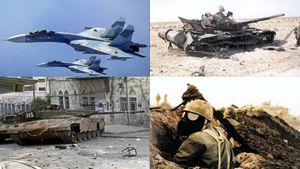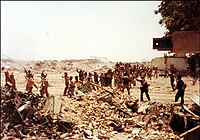Judea Crisis
| Judea Crisis | |||||||
|---|---|---|---|---|---|---|---|
 Clockwise from top left: Two Pavulturilori Air Force Arlet Ar-85 "Paloș" on patrol, a destroyed Sconian tank, Sconian troops preparing to assault a Pavulturilori position, a Pavulturilori T-85 Înger in Aktonia. | |||||||
| |||||||
| Belligerents | |||||||
|
| ||||||
| Commanders and leaders | |||||||
|
| |||||||
| Units involved | |||||||
|
| |||||||
| Strength | |||||||
| 1,000,000 | 800,000 | ||||||
| Casualties and losses | |||||||
|
| ||||||
The Judea Crisis, also called the Judea War, was a major war fought between Pavulturilor and the Islamic Republic of Sconia. The war, fought between May and November 2008, was the first major war in Ecros during the 21st century and involved multiple countries. For decades prior to the war, Sconia under Caliph Ali Al-Nour had had strained relations with neighboring Pavulturilor, claiming the region of Judea as integral Sconian territory.
The war began in May 2008 when Sconian forces invaded Judea, seeking to expand Sconia's territory. The Sconian offensive stalled after around one month, during which, Pavulturilor became a full member of the Cooperation and Development Coalition (CODECO). With CODECO's materiel support and Creeperopolis' direct military intervention, Pavulturilori forces launched a counter-offensive and invaded Sconia. The war ended with the capture of Aktonia, the capital city of Sconia.
After the war, Al-Nour was captured and criminally tried by a Pavulturilori court. He was found guilty of various charges and was sentenced to death; he was executed by the Pavulturilori government in 2010. Following Al-Nour's overthrow, the Sconian government democratized and removed Al-Nour's influence and ideology from the country.
Background
History of Judea
Rule of Ali Al-Nour
Prelude
Al-Abqari satallite incident
On 4 April 1996, the Islamic Republic of Sconia launched the Al-Abqari satallite to space from tbd launchsite, while claiming the satallite to be a weather satallite, the Kingdom of Pavulturilor claimed that it was an Armed satallite in direct violation of the Outer Space agreement, and that if the satallite was to pass over Pavulturilor, they will have every right to shoot it down. 00:00 5 April 1996, the satallite would enter low orbit above Pavulturilor, which issued a final warning to Sconia, that if it was to not make the satallite self desruct immidetly, it would resort to destroying it itself, Sconian officials refused and stated it would be illegal for Pavulturilor to do so.
10 minutes later on 00:10 WPT a Royal Pavulturilori Air Force FA-12 "Arbaletă" armed with a special variant of the DM-80 Brutalizator would intercept the satallite, scoring a hit on the satallite in 00:24 WPT, damaging it, however failing to kill the target.
Minutes later on 00:30 WPT the Stratigic Defence Command launched a Săgeată 2 missile to intercept the satallite, the Săgeată missile would successfully intercept the satallite 10 minutes later in 00:40 WPT and destroy it.
The Islamic Republic of Sconia would go on to try condemn the Kingdom of Pavulturilor with TCN resulution tbd, it would ultimatly fail to do so with the results being TBD for, TBD abstain, and TBD against.
tbd
Course of war
Invasion of Pavulturilor
On 25 May 2008, Al-Nour, declared war on Pavulturilor and launched a full scale invasion of Pavulturilor, with the aims to claiming the Judea region. The invasion overwhelmed most of the local Royal Pavulturilori Army garrisons, however, the invaders weren't able to progress further due to the inability of the Sconian Air Force to establish arial superiority over the country.
Sconian advance stalls
Despite the initial numerical advantage of the Sconian Military, many Pavulturilorians re-enlisted in the armed forces to defend the country from the Sconian invasion. The large amount of new Pavulturilori soldiers helped contribute to stalling the Sconian offensive. During the offensive, Sconian forces began sieging the city of Fălița; at the time, the city was the last defense before Sconian forces reached the Pavulturilori capital of Dăbuza. After one month of fighting, the siege was lifted and heavily relaying on Crabin volunteers.
Meanwhile in the Negba desert the Sconian Army, while initially establishing a firm foothold, has since not been able to advance out of it due to a bloody guerilla warfare campaign waged by local beduein tribes and remnants of the Royal Pavulturilori Army, who relied heavily on Negba camels to conduct hit-and-run attacks on sconian convoys, with several key engagments such as Battle of Sinai Mount, Battle of Lahav junction, and the Deffense of Zamănești in which Sconian forces have suffered massive casualties that have set them back considerably, requireing them to regroup, this would allow Pavulturilor to initiate a counter offensive.
Pavulturilori counter-offensive

With the Pavulturilori government negotiating its full entry to the Cooperation and Development Coalition (CODECO), it received supplies and military support against Sconia. The Pavulturilori high command created an ambitious plan to invade the entirety of Sconia in a few months, with the plan utilizing the fresh supplies received from supporting countries, mainly Creeperopolis.
Operation Sabie însângerată
On 01:00 1 July, the Royal Armed Forces of Pavuturilor, with assistance of the Creeperian Air Force, have launched a massive SEAD operation, with the goals of destroying sconian air defense battaries in the western half of the country. In response, the Sconian Air Force was sent to intercept the attack.
The result would see the destruction of 3 fourths of aircraft in possestion of Sconia, as well as the destruction of 30 Sconian air defense battaries, with no aircraft lost on the Creeperian-Pavulturilori side, the operation would be concluded merely 5 hours later on 06:00, four hours later on 10:00 a ground assault would begin, the operation would be considered one of the most successful air campaigns in modern military history.
Battle of Khafji
on 3 July, the Royal Pavulturilori Army would reach the Sconian city of Khafji, while the Royal Pavulturilori Navy's Royal Caelean Fleet engaged with the Sconian Navy in the waters around the city to allow for a marine landing, heavy fighting insued the following day west to the city as well as in the water north to it.
Sconian naval assets in the area would either retreat or be destroyed in the two following days, at the cost of 5 Pavulturilori missile boats 3 corvettes, and 1 destroyer. While the Sconian defense of the city stood strong initially, following the landing on 7 July, the defenders of the city were overrun and surrendered en mass, and by 11 July, outside of a few fanatic pockets of resistance, the city fell under Pavulturilori occupation, while the rest of Pavulturilori forces have bagan to move on Aktonia.
Battle of Tabuk
In tandem with the advance on Khafji, Pavulturilori Forces have reached the city of Tabuk on 3 July too, and have mounted a tri-front attack on the city, wanting to capture the city quickly, and by that to allow Sconian soldiers to retreat and abandone their positions, which after 2 weeks of fighting, the Sconian forces were issued the order of general retreat from the city, and gave it up to Pavulturilori forces, who did not waste time and chased the Sconian troops to the city of Tira.
Battle of Tira
After chasing Sconian toorps out of Tabuk to Tira, where a secondary defense line was established, Pavulturilori forces have reached the line on 29 July, which took over a month, until 30 August to breach and to fight inside the city, which Pavulturilori high command refused to bomb due to the city's rich jewish history, being once the home of the Templar Order, this however gave the Pavulturilori forces a much nessarry moral boost and by 11 September, the city of Tira would fall in the hands of Pavulturilor.
Battle of the Red Sea
Pavulturilori high command feared that Sconian forces would be able to regroup and mount a computent defense to their assaut of the Sconian heartlands, and so on 15 August the Royal Romanyan Sea set course to the Red Sea to enable another landing operation in Zarfor, however, the ships were detected by the Sconian Navy and on 18 August vessels of both navies have engaged in battle, with the Royal Pavulturilori Navy coming out on top, sinking qll sconian ships in the area at the cost of 2 destroyers.
Battle of Zarfor
Following the naval victory in the Red Sea, Royal Pavulturilori Marines would land on the shores of Zarfor with the support of naval artilary on 20 August and make their way fighting Sconian forces street to street in urban combat and by the end of the month, on 30 August the last Sconian soldiers in the city surrendered as the frontlines started to collapse.
Battle of Aktonia

After five months of fighting since the beginning of the war, the frontline of the Sconian army collapsed and the Pavulturilori forces quickly advanced to the country's capital of Aktonia. The battle for the capital persisted for two months. The battle culminated in the attack on the Aktonia Palace on 28 November 2008. The palace fell at 6:00 p.m. local time and Al-Nour was captured. Later that day, Pavulturilori leaders declared that the war was won.
Aftermath
Casualties and losses
Occupation of Sconia
Legacy
Government reforms in Sconia
Almost after the trial of Al-Nour, Sconian people and pro-democracy Sconian officials came together to reform the country based on the Rashidun Caliphate in everything including a fair elective system.
The new government basis Islamic Law on the Quran, Hadith and Fiqh and Removed the false Hadiths that Al-Nour wrote, and his false teachings of Fiqh, the new government seeks to make good relations with other nations.
